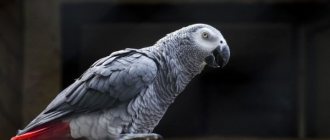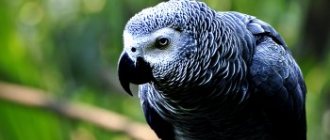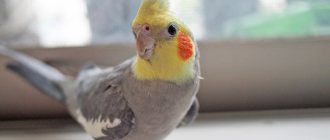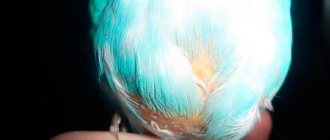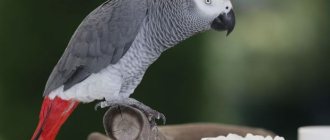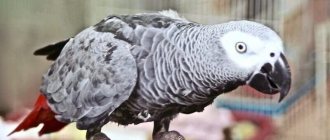The gray parrot or gray parrot is a popular pet that can be easily taught to talk. The world record for memorizing and reproducing the maximum number of words belongs to a representative of this species, more than 700 words.
The bird is medium in size, has a wingspan of just over half a meter and weighs 500-600 g. The bluish-gray plumage on the body is complemented by bright red tail feathers. The eyes are yellow. The area around the eyes and the cere are devoid of feathers. The beak is large, curved, black. The paws are powerful, gray, equipped with sharp claws.
By nature, individuals are calm, inquisitive, and easily make contact with people.
The average life expectancy at home is 30-45 years, some individuals can live up to 60 years.
What does the price depend on?
The cost depends on a number of factors:
- age (young animals are cheaper);
- varieties of color;
- gender;
- origin (well-known nurseries that sell guaranteed healthy birds with a veterinary passport charge a high price);
- level of training.
When planning to buy a Gray, it is important to decide what the feathered pet is for. It is bought simply for beauty and communication, the plan is to breed parrots, or the owner wants to seriously engage in training the pet.
Important! Young males are more suitable for learning human speech. They are more friendly and get used to their new owner more easily.
How much do gray parrots sell for?
There is no clear answer to the question of how much a gray parrot costs. Prices range from 20 to 300 thousand rubles . This price range is due to different categories of birds sold.
- Aviary and fosterlings.
The first chicks are raised by their parents in a flock , in conditions close to natural. Such grays are hardy and strong, but they are somewhat wild and difficult to adapt to home conditions. The price of young individuals does not exceed 50,000 rubles.
Fosterlings are raised artificially by humans from birth . They are more tame, affectionate, and perfectly adapted to life in a small cage. They do not require mandatory contact with relatives. Their cost is close to 100,000 rubles.
- Brown-tailed and red-tailed.
Based on the color of their plumage, there are animals with brown tail feathers and bright red ones. Individuals with a scarlet tail are considered more valuable, as they are larger and have developed intelligence. Their cost exceeds 100 thousand rubles.
A bird that does not have documents, illegally brought into the country costs about 25,000 rubles at the market . A Gray from a nursery , ringed and with a passport, will cost 120-250 thousand rubles .
Description and features
The African parrot is different from most members of the parrot family. This is a gray bird, rather inconspicuous in appearance. She does not have bright multi-colored plumage, but her color is remarkable in its own way.
What does a gray parrot look like? Let's draw his verbal portrait:
- The body is covered with gray feathers of different shades: from mother-of-pearl to graphite.
- On the head and neck the tips of the feathers are light with an interesting scaly pattern.
- From the chest to the undertail and thighs, the feathers gradually become lighter. The skin of the fingers is rough, formed by ashy-colored scales.
- The outer surface of the wings is the darkest in relation to the total mass of the plumage. The flight feathers are almost black.
- The short, spade-shaped tail is red or brown, depending on the type of bird.
- On the head there is a white facial mask - around the eyes and on the bridge of the nose there are unfeathered areas in the form of “glasses”.
When describing a gray parrot, one cannot fail to mention two striking details: a powerful black beak with an elongated tip and expressive eyes. The chicks' eyes are black and shiny, but over time the iris becomes yellow. In particular, by this sign you can recognize the age of the parrot.
The Gray is strong and stocky, its body length is 30-40 cm, its weight is approximately 500-600 g, its wingspan is 60-65 cm. Females are slightly smaller, but their color is the same as that of males.
Where to buy gray
Parrots of this species can be purchased at bird markets, through advertisements on the Internet, from private breeders, in pet stores, and in large nurseries.
Advice. Experienced poultry farmers do not recommend buying Grays in markets or through advertisements, because there is a high risk of adopting a sick animal.
Well-known breeders value their reputation, so they strictly monitor the health of their charges. When purchasing a parrot from a nursery, the new owner is provided with a full report on the vaccinations performed and the results of the parrot's tests. Inexperienced poultry farmers are provided with informational assistance on the care and training of African Grays.
There are several nurseries and private breeders in Russia:
- Violetta Gudkova (Moscow);
- Nursery of large parrots ATOL (Moscow);
- Andrey Mikhailov (St. Petersburg);
- Larson (Perm);
- Nursery Jaco (Moscow).
Exact contacts of breeders can be found on poultry breeding forums and at exhibitions.
Types of gray parrot
African gray parrots have a memorable appearance. They cannot be confused with other birds. The following types of Grays are known, distinguished on the basis of external characteristics:
- Redtail. Ash plumage, black beak, red tail. Red-tailed gray
- Brown-tailed. The body size is smaller and the feathers are darker than those of the redtail. The mandible is brownish-beige on top, the tip and mandible are black. The tail is chestnut.
Brown-tailed gray - Jaco Princess of Ghana (royal). The largest of the three subspecies. Distinguished by red speckles on gray feathers. In some individuals, red color predominates, and gray feathers grow in a chaotic manner.
Royal Gray
Of course, the royal variety of gray parrots is the most original and attractive among the gray parrots, but also more rare. In nurseries, individuals with unique colors are bred: albino chicks and multi-colored parrots are produced. Such birds cost much more than gray ones.
How to teach to talk
You can achieve success in training a parrot by showing persistence and perseverance. Lessons are given 7-10 minutes daily. At this time, the student should not be distracted by extraneous sounds or the presence of relatives. It is better to practice in the morning, placing the cage in a small, shaded room.
The words must be pronounced clearly, with the same intonation, repeating each 50-100 times. You should not immediately tell your parrot long sentences. To begin with, prepare short words and monosyllabic phrases, such as “Kesha wants to eat,” “what time is it,” “it’s good.”
The first results of training appear after 4-6 weeks.
What can Grays get sick of?
Infections and diseases caused by improper care can occur in poultry. Diseases contagious to humans include psittacosis and salmonellosis.
With salmonellosis, the animal suffers from diarrhea (greenish-yellow droppings), exhaustion and often death. A parrot becomes infected with Salmonella through physical contact with a sick parrot, through dirty feeders, a cage, or protein food. You need to treat with antibiotics, which will be recommended by a veterinarian.
Psittacosis is a virus spread by sick individuals. The disease can occur in a chronic or acute stage. A sick Gray has dull, disheveled plumage, is inactive, and loses appetite. Treatment is complex and includes antibiotics and vitamins.
Parrots can be bothered by the downy feather eater, a parasite that feeds on skin particles and feather rudiments. It causes a lot of anxiety, causing the bird to itch and even pluck feathers. Sick individuals are treated with insecticidal preparations.
Improper feeding leads to the development of gout (inflammation of the joints), and an unfavorable emotional background and stress in the family can cause the parrot to pluck itself.
Gray's intelligence
Like most parrots, Grays have the ability to “talk.” However, in comparison with other species, it wins by a huge advantage. An African can not only remember and clearly reproduce several hundred words and phrases, but also use them appropriately. If other parrots only repeat (imitate) what they hear, then the gray parrot knows how to conduct a dialogue with a person and is open to new knowledge.
Did you know? In America, a domesticated Gray named Baby assisted the police in catching criminals - he remembered the names of the robbers who entered the apartment and named them to law enforcement officers.
A smart bird needs constant training. You can endlessly be amazed at the intellectual abilities and physical capabilities of the Gray, especially if you raise your feathered pet correctly. This is not difficult to do, given that a gifted “student” responds with interest to educational games and copes with the assigned tasks.
The gray parrot is not a gift bird at all. The Gray's character has such traits as irritability, rancor, and jealousy. He tries to dominate, but, having received a rebuff, does not rest on this. He chooses a “favorite” in the family and follows him everywhere, participates and helps in all matters.
How to keep a Gray Gray: tips for the owner
The pet's cage should be located away from drafts , away from radiators and not on the windowsill. The optimal room temperature is +22 +26 degrees, humidity 55-65%.
In winter, it is recommended to irradiate your pet with a special UV lamp to enhance the production of vitamin D in the body. Irradiation time is 15 minutes.
It is better to feed Grays with specialized food mixtures, but you can also give individual products from the “human table”. This:
- pieces of fresh fruit (apple, watermelon, banana, apricot, melon);
- nuts (Brazilian, cashew, walnut, pine, almonds);
- cauliflower;
- zucchini;
- carrot;
- cucumbers;
- corn;
- crumbly porridges (rice, pearl barley, buckwheat);
- berries (grapes, strawberries, blueberries, blueberries, currants, cherries, gooseberries);
- fresh nettle, dandelion, quinoa.
Attention! You cannot give fresh bread, meat, mangoes and avocados, spicy herbs, peanuts, white cabbage, potatoes, milk, sugar.
Reproduction in captivity
When selecting parental pairs, it is important to correctly distinguish a male from a female. Sexual differences in African Grays are subtle, and sex can certainly be determined by DNA testing. Externally, the male looks larger and “coarser” than the female.
A pair of parrots are kept in a spacious enclosure , which is equipped with perches, feeders and a spacious nest box (45*45*30 cm). If the birds like each other, a clutch of 3-4 eggs will soon appear in the nest.
The female incubates the eggs for a month. The male Gray carefully looks after her, bringing her food and protecting her from enemies.
The chicks hatch naked and fledge only at 2.5 months. Young individuals leave the nest at 4 months.
Habitat and lifestyle
The distribution area of the gray parrot is the African continent, or rather its central and western regions: Guinea, Congo, Gabon, Cameroon, Tanzania. In these places the equatorial forest belt of Africa is located. On the west coast there are mangrove forests where African parrots love to live. In addition to mainland areas, parrots are also attracted to the islands of the Gulf of Guinea.
Grays have a highly developed family instinct; they cannot live alone, so they form flocks of several hundred individuals. When the nesting season arrives, married couples form within the colony. The female sits on the eggs, and the male guards the nest and carries food to the partner.
They roost for the night in the dense crowns of tall trees. There, hiding in the foliage, they spend the hottest part of the day. At dawn, the flock goes to the pond and in search of food. There are plenty of food sources in the forest: these are shrubs and grasses with various seeds, fruit and berry trees, and edible roots. When there is not enough food, birds raid farmland and destroy fields. Because of this, feathered thieves often fall under bullets.
Jaco in the wild
Grays have many enemies among representatives of the animal world: snakes, birds of prey, rodents that steal eggs. A particular threat comes from human poachers who hunt parrots for sale.
This is interesting! Gray parrots are known for their caution, they are able to hide from predators and signal danger to each other. In order not to attract attention to itself, the bird quickly and deftly moves along the trunk, clinging to the branches with its beak.


